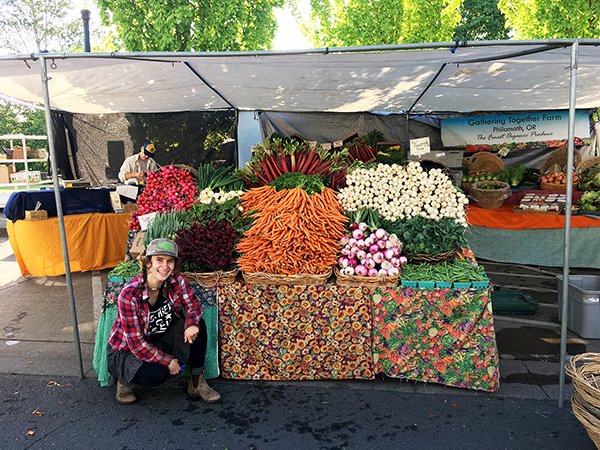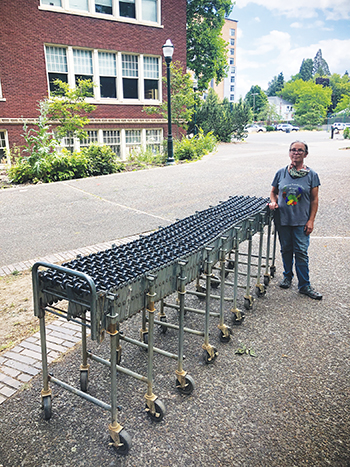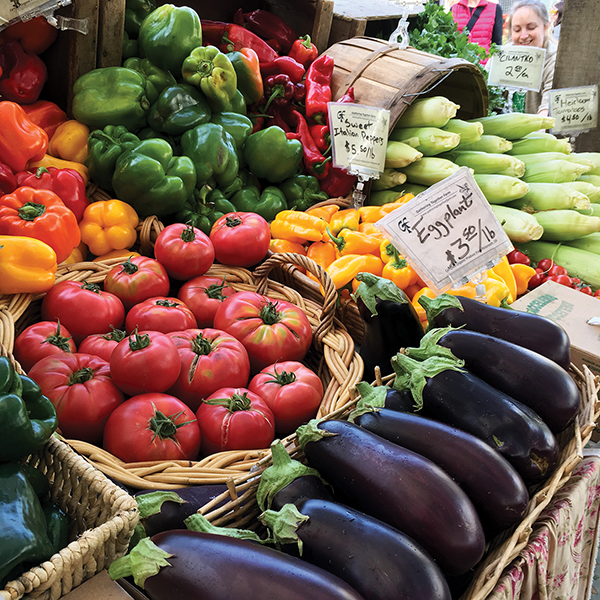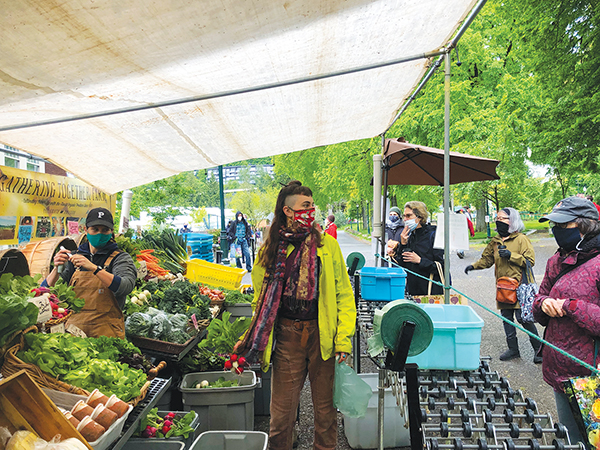Farming is a whole lot more than just growing crops. In fact, I would argue that oftentimes seed to harvest is the easiest part. Washing, storage, transport, and marketing can make or break our growing efforts. A farmer once told me, “The pack shed is the bottleneck of the farm.” After managing pack sheds on multiple farms, I can’t agree more.
When efficiency and precision are maximized in the pack shed, selling becomes that much easier. Farmers markets are the crux of our work as growers. But, if produce doesn’t arrive properly washed, stored, labeled and organized, markets are harder than they need to be.
Having crisscrossed the country visiting dozens of farms and markets from east to west, I am consistently amazed by the innovative approaches to post-harvest handling and marketing and have become a little obsessed with cross-analysis of farm systems. Every farm is fascinatingly different, yet we can mesh and mold methods to our own context.
 The author at Gathering Together Farm's market in Oregon.
The author at Gathering Together Farm's market in Oregon.
Pack shed efficiency
When I first visited Steadfast Farm in Mesa, Arizona, I was absolutely blown away by the efficiency and simplicity of their pack shed setup. It is an outdoor concrete pad beneath the awning of two modular buildings. There are two horse trough jacuzzi bubbler systems with Hudson fill valves, salad spinners, high pressure spray guns and rolling metal shelving units for drying.
Everything is modular, organized, and automated. Dirty produce comes in one side and clean produce goes straight to the cooler on the other. You can turn on water and walk away without worrying about overflow. You can drain tubs, spin salad, and load totes with little effort, allowing you to use transition times for other tasks.
After working on several larger, less-streamlined operations, Erich Schultz’s minimalist approach at Steadfast forever changed the way I think about pack sheds. Of course, Jean-Martin Fortier, Curtis Stone and others have taken the internet by storm with designs like bubbler systems and washing machine salad spinner conversions.
These innovations have radically improved washing efficiency on small farms, but I’ve learned that pack shed design isn’t only about the physical arrangement of tables and the latest washing equipment. It is the operating procedures that set apart an efficient pack shed from a stressful soggy mess (well, planning a proper drainage system also helps).
Standardization
When managing the pack shed at Hayshaker Farm in Walla Walla, Washington, I came to appreciate the power of standardization. We always went for standardized case numbers, for example, 24 little gem lettuces per case, or 30 bunches of carrots per tote. Labels were always placed in the top right of the box or tote for easy reference.
When coordinating 20-plus wholesale accounts and two consecutive market harvests, I also came to love their unique order fulfillment spreadsheet. All the fancy apps and technology of today certainly have value, but I think that something goes off in the human mind when you physically highlight or cross off an item from a list.
 The collapsible roller table that acts like a conveyor belt and makes packing 600 CSA boxes a breeze at Gathering Together Farm in Oregon. Photo Courtesy of Laura Bennett.
The collapsible roller table that acts like a conveyor belt and makes packing 600 CSA boxes a breeze at Gathering Together Farm in Oregon. Photo Courtesy of Laura Bennett.
Hayshaker’s order clipboard offered that simplified reward system of washing and packing directly into boxes, and then highlighting each component of the order as we went along. Workers and management could always see exactly where we were in the process and what was missing. Systematic improvements like this are both cheap and highly effective.
 Gathering Together Farm market display.
Gathering Together Farm market display.
Assembly-line mentality
Small farms are obviously not factories (and we definitely don’t want them to be), but the assembly-line format is still valuable in the pack shed. Distinct “in” and “out” points keep produce cleaner and more organized.
At Gathering Together Farm in Oregon, packing 600 CSA boxes was a breeze with a collapsible roller table system that acts like a conveyor belt. Produce comes in one side of the barn and is washed and distributed in totes. Then, the condensed 10 foot conveyer is expanded to 40 feet long.
 This conveyer belt system also proved very useful for sanitized, minimal-touch order fulfillment at COVID-era farmers markets. Photo Courtesy of Laura Bennett.
This conveyer belt system also proved very useful for sanitized, minimal-touch order fulfillment at COVID-era farmers markets. Photo Courtesy of Laura Bennett.
Workers stand in a zig-zag formation with pallets of each produce item while each CSA tote comes down the line and receives the proper amount of product at each point. Totes are loaded on pallets or trucks and moved to the cooler to be delivered to their respective drop-off points. This conveyer belt system also proved very useful for sanitized, minimal-touch order fulfillment at COVID-era farmers markets.
Affordable packing buildings
When building an incubator farm at Stonewall Farm in Keene, New Hampshire, we quickly realized that the expense of packing areas can be cost prohibitive for many farms. Our friends at Urbavore Farm in Kansas City, Missouri, have taken an eco-economical approach by transforming used shipping containers into simple cooler and packing rooms. Others have built their pack sheds inside of high tunnels.
I’ve seen ultra-efficient pack sheds made out of lean-tos, simple market awnings, and prefabricated sheds. Packing areas don’t need to be fancy, so long as the flow and systems keep things moving efficiently down the line. Oh, and having the cooler as close as possible is always a bonus.
The best farmers market displays
Just like pack shed systems, crafting a predetermined plan for market setups is the key to success. However, the definition of a successful farmers market weekend is different for everyone. I’ve talked to farmers who made a couple hundred dollars or a couple thousand each market. And, I’ve worked at market booths that grossed upwards of $8,000 to $10,000 every Saturday. While these may be exceptional examples, all of the farms I have worked for that consistently gross over $2,000 in market sales each week have major commonalities.
Clear signage: For one, their signage is big and clear. Customers should never have to ask “how much is this?” Studies of buying habits show that customers are more likely to buy a product when they know exactly how much it will cost. The price is never masked or difficult to calculate. Their eyes move directly from the pretty vegetable to the cost. Large readable prices are always placed right next to each item (as opposed to a menu of prices). Plastic clips or thumbtacks can hold dry-erase or chalk signs for easy displays.
By the each: Using that same train of thought, marketing “by the each” is becoming increasingly popular. I’ve seen magnificent success for farms that use pint containers, bags, or “boats” to put a fixed price on items that are usually sold by weight.
The secret is, it doesn’t even have to be a deal or discount; it is just drawing in the customer with a clear understanding of what they will spend. In other words, pints of Brussels sprouts or boats of zucchini are sold as if they are by the piece rather than by the pound. Piles of winter squash or cauliflower can be separated into $3/ea, $5/ea, and $7/ea price points. Tomato flats can be pre-sorted by weight and labeled “$2/ea, this box only, etc.
Again, this follows the psychology of customers who want to know what they are getting into without guessing. Given recent restrictions on customer handling of produce, switching to itemized “by the each” sales methods can also make lines move faster because less bagging and weighing is required.
Go vertical: Empowered Flowers in Oregon City, Oregon, uses 2x4s and miscellaneous chunks of wood to elevate the back portions of their tables, adding multiple layers to a display. Instead of setting things flat on the table, they also add wood chunks underneath baskets and boxes so that the produce is always angled slightly forward, creating an appearance of overflow and adding dimension. I’ve also seen successful farm displays made of custom welded aluminum, stacked wooden boxes, or angled plastic grates.
“2 for” deals: A good old fashioned “1 for $3,” “2 for $5” or “3 for $8” wins customers over every time. A big area of your display can be dedicated to “mix and match” 2-for deals to add an extra element of attraction. I’ve seen this be especially effective with bunched greens like chard, collards and multiple varieties of kale. This tried-and-true marketing technique increases the average transaction as well as overall consumption by utilizing the psychology of urgency and discounts.
Illusion of abundance
The best farmers market displays are undeniably beautiful and one of my favorite artistic expressions. A layering of colors, shapes and textures draws customers in. But, it is the illusion of abundance that holds their attention. “Pile it high and watch it fly,” everyone says.
 Gathering Together Farm market display.
Gathering Together Farm market display.
Even if you don’t have the volume of produce to maintain continuously huge piles, simple tricks help maintain that abundant appearance. For example, I have seen many farmers simply stack empty tomato flats beneath full ones. I also have often used the “filler technique” of bunching up fabric in the bottom of a basket or box and then piling produce on top to make it look fuller. Overflowing smaller containers is typically better than underfilling a larger basket.
To maintain abundance all the way to the end of market, the most successful booths I’ve worked for always downsize the display as things sell out. By removing tables and consolidating produce, offerings still look full and attractive to late-arriving customers. Also, top farms never discount their produce later in the market because this drives down the perceived value of products.
Contrasting colors: Use basic color theory to contrast different vegetables and make them stand out. For example, alternate red bell peppers with yellow squash and purple eggplant rather than a big block of red beets, red tomatoes, and red bells. Color marketing is a fascinating topic in and of itself, but the basics are enough to make a huge difference in a farmer’s market stand.
Big colorful banner and clear growing practices
The bigger and more colorful your banner, the better. Ideally, a high-quality printed banner should cover most of your booth’s back end so that it can be seen from afar. Including images of the farm, like the Urbavore Farm display does, makes customers feel connected to your growing practices even if they’ve never visited your property. Largely and clearly displaying your organic certification or key words about your growing practices cuts down on questions and draws more people in.
Farm photos of pollinator areas, wildlife, and lush growth also improve the association of your farm brand with ecological, regenerative, and organic growing practices. If you don’t have any certifications, you can experiment with side banners that briefly explain practices like no-till, pollinator-friendly, pesticide-free, or use of compost rather than synthetic fertilizers. With growing mainstream popularity of the book and movie “Kiss the Ground” and the like, I think that customer education is an important trend. Just like the terroir of wine, when your food tells a story and has a special regional flair, people feel they are getting a special experience.
Cherry-picking from the best
Ultimately, I’ve found that the best farming systems are personalized. Copying and pasting somebody else’s setup almost never works the way you think it will. By exploring what others have implemented, we can cherry-pick the elements that work best for us in our specific context. Meshing together the innovations of all the brilliant small farmers out there allows us to craft unique and functional solutions to the hurdles of post-harvest handling and market sales.
Logan Hailey is a farmer, writer, and co-owner of Ramblin Farmers LLC, a mobile freelance farmhand service.


